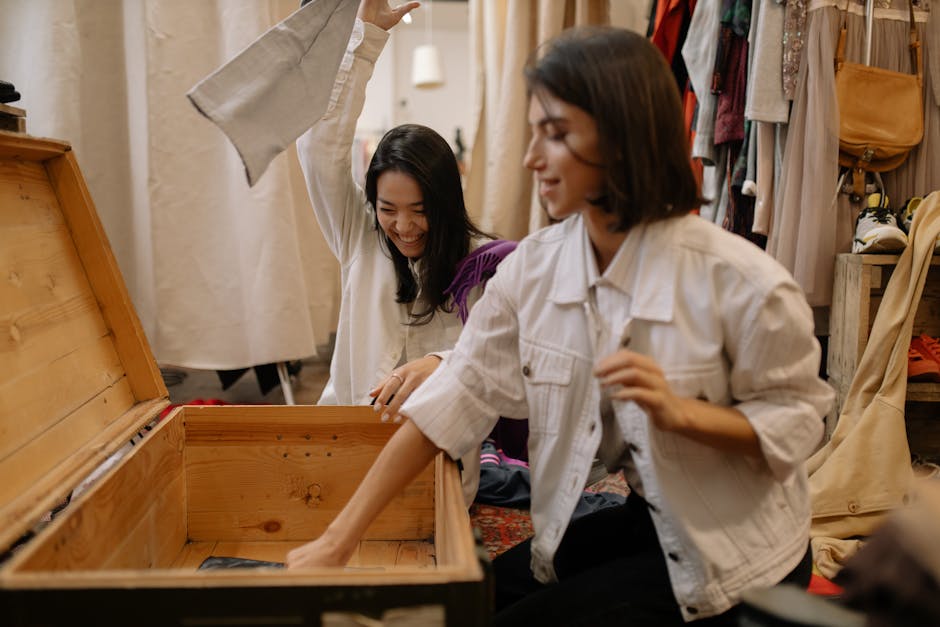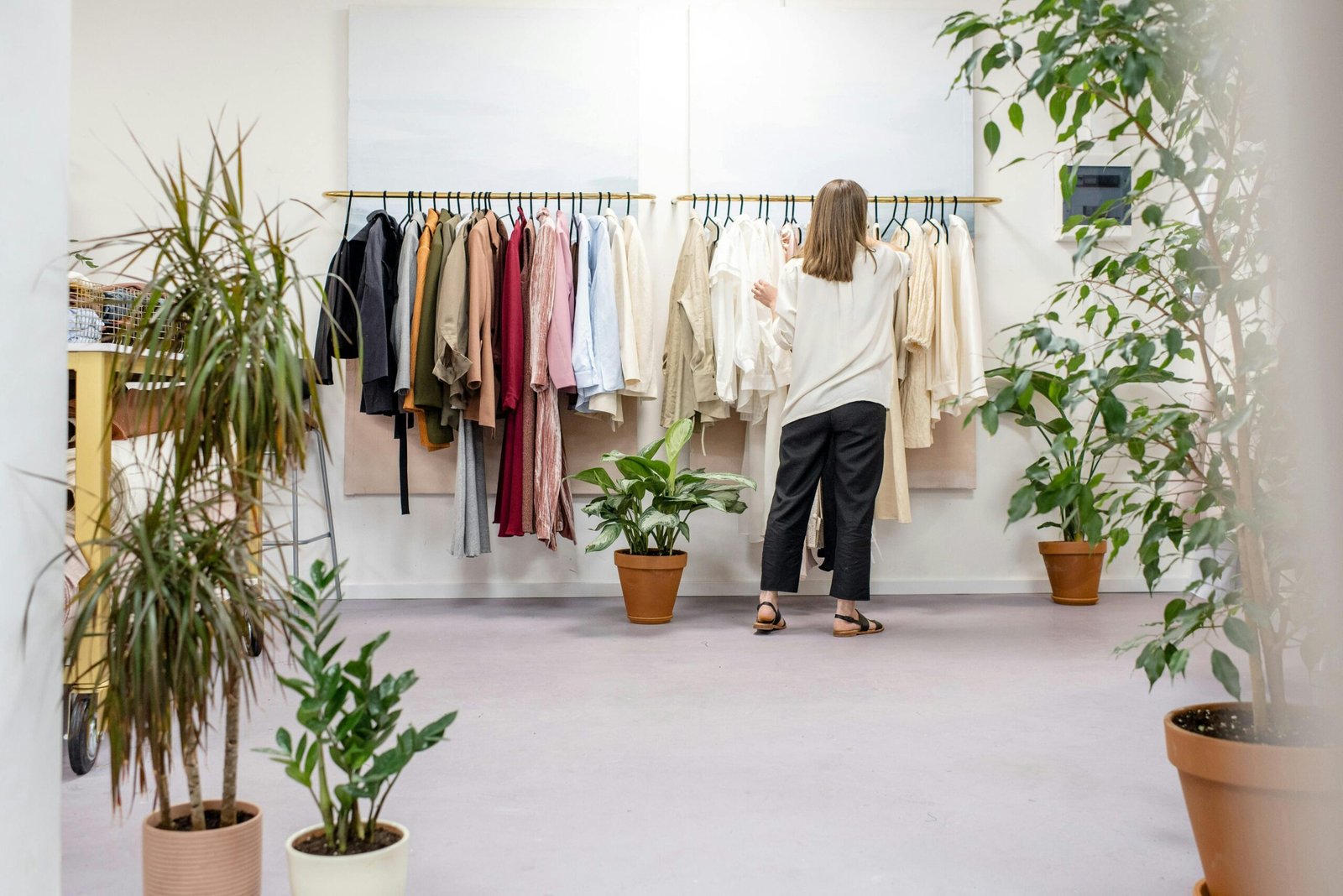Introduction
Welcome to this sustainable fashion journey where we explore the heart of eco-friendly wardrobes; a crucial matter that speaks volumes about our relationship with the environment. At present, the world is buzzing with talk of fast fashion – high-turnover, disposable garments that flit in and out of trend at breakneck speed. It’s a tempting choice, for sure, but this rapid consumption comes at incredible ecological costs, setting the stage for the importance of exploring alternatives.
Sustainable fashion, a term we are getting comfortable with lately, is here to rescue us from the pitfalls of fast fashion. Choosing sustainability and weaving it into our lifestyle is more relevant now than ever, and what’s a better place to start than our wardrobes? In this article, we acquit you with the concept of sustainable fashion, its importance, and how to seamlessly infuse it into your lifestyle, ensuring you have an eco-gorgeous wardrobe. Get ready to embrace fashion that not only makes you look good but feel good too, all while doing right by our planet. It’s going to be an enlightening journey, so let’s get started.

Understanding Sustainable Fashion
What exactly is sustainable fashion? In simple terms, sustainable fashion refers to practices in the clothing industry that prioritize the health of our planet and its inhabitants. It incorporates a myriad of elements including the ethical treatment of workers, the usage of eco-friendly materials and dyes, minimal waste creation, and a low carbon footprint. Elements of sustainable fashion extend far beyond the manufacturing process, often involving considerations about how clothes are packaged, transported, and eventually disposed of or recycled.
Why is this concept finding its way into our modern vocabulary, you might ask? Well, with alarming rates of deforestation, pollution, and a myriad of other environmental issues facing our world, every industry, from tech to textiles, has a responsibility to soften its footprint. Terms like ‘eco-friendly clothing’, ‘green fashion trends’, and ‘ethical fashion brands’ reflect an ever-growing movement towards incorporating sustainability into our everyday choices, including what we wear. Clothing isn’t just about personal expression anymore; it’s about expressing our commitment to the planet.
Essentially, sustainable fashion is a call to shift away from excessive consumerism—where clothes are often produced and dumped at alarming speeds—to a world where we value what we own, know where it comes from, and understand the impact of our fashion choices. The onus isn’t just on corporations to change their practices either; as consumers, we wield enormous power. Every clothing purchase we make either contributes to the problem or the solution. By understanding and championing sustainable fashion, we can all make a difference, one outfit at a time.

The Problem with Fast Fashion
Fast fashion, a term that has been splashed all over media platforms for a good reason. Fitting quite literally, it signifies the rapid pace at which fashion is produced, consumed, and then discarded. This phenomenon hinges on constant supply and demand churn, fueling the production of low-cost clothing that mirrors the latest runway trends.
Now, the issue herein lies in the staggering consequences it imposes both on the environment and society. The fast fashion industry is one of the largest polluters globally, standing second only to the oil industry. From enormous water consumption to large-scale greenhouse gas emissions, the production process of fast fashion has intensive environmental impacts. Aerate over this for a moment: approximately 1,800 gallons of water are consumed to create just one pair of jeans. Yeah, it’s that mammoth!
Furthermore, fast fashion garments, typically made of unsustainable fabrics, take hundreds of years to decompose while releasing harmful chemicals into the environment. Some scary stats point out that over 70 million barrels of oil are used each year to produce polyester fibers, a non-biodegradable material used widely in fast fashion clothing.
Then there’s the human toll, which is often overlooked. Fast fashion factories, often located in developing countries, are notorious for appalling working conditions and meager wages. Child labor, exploitation, and human rights abuses are common complaints in this industry.
Placing this in stark contrast with sustainable fashion, which encourages fair trade, ethical production techniques, use of eco-friendly materials, and longevity of products, it’s obvious where fast fashion falls short. It’s about choosing quality over quantity, long-lasting pieces over one-season wonders, and conscious consumption over mindless buying sprees.
In the face of these troubling facts and figures, the discourse shifts from the colors and cuts of clothes to the footprints and impacts. Hence, shifting from fast fashion to sustainable fashion isn’t just a style statement, but rather a testament to our responsibility as global citizens. It’s high time we removed the fashion blinders, stepped beyond the thrill of cheap thrills, and grappled with the serious problem of fast fashion.

Incorporating Sustainable Fashion into Your Life
Switching to sustainable fashion might seem like a momentous leap, right? Well, don’t let that put you off! The awesome part is that it’s more about small, mindful steps than a gigantic superman-leap. The goal here is to minimize waste and promote a system that values fair treatment of people, animals, and the planet. That sounds doable, right?
So, the first mantra of sustainable fashion is buying less. That doesn’t mean you have to deny yourself the joy of owning lovely clothes. Instead, it means choosing quality over quantity. Consider swapping hundreds of wear-once outfits for a smaller collection of high-quality items that are built to last.
Next in line is reusing and recycling. Treasure your clothes and when they do reach their lifespan, don’t just throw them away. Instead, recycle or hand them down. There are numerous charities that will upcycle clothes, or, you could get creative and repurpose them yourself.
Let’s not forget, happiness is fixing that snag, button, or hem rather than discarding a garment. Back in the day, mending was an art. Reviving that skill could save you dollars while acting as a stress buster – a sort of clothes-yoga thing.
Now, for the benefits. Dipping your toes into sustainable fashion is not just good for the planet; it can be good for you too. Choosing well-made clothing made of high-quality, sustainable materials can be a luxurious experience, it feels wonderful against your skin, lasts longer and sets you a class apart.
Remember, each time you purchase an item of clothing, you’re casting a vote for what kind of world you want. So, in our everyday life, even as fashion enthusiasts, let’s help flip the script from ‘disposable fashion’ to creating a ‘sustainable fashion routine’. Let’s blaze the trail and enjoy the benefits of an eco-friendly wardrobe. Trust me, the planet will thank you and, you might just start a new trend!

Investing in Eco-Friendly Clothing
Rolling up our sleeves, let’s dig into the nuts and bolts of why investing in eco-friendly clothing is more than just a passing fad. It’s something that should be nurtured, and cared for, much like the pristine environments we’re striving to protect.
Firstly, let’s start with what actually makes clothing eco-friendly. For starters, it has to do with the type of fabric material used – think organic cotton, recycled polyester, natural fabrics like hemp, linen, or even innovative materials like Tencel (fabric derived from sustainably harvested trees). Yep, eco-fashion screams creativity.
The production process is a key player too. Low-impact dyes, energy-efficient processes, fair-trade practices – all these aspects contribute towards labeling a piece of clothing as eco-friendly. It’s all about minimizing ecological footprints and treating Mother Nature with the respect she deserves.
Now onto the biggie: why should you, the style-conscious, eco-warrior, invest your hard-earned quids into eco-friendly clothing, you may ask. Well, in the long run, you’re not only reducing your impact on the environment but also promoting ethical labour practices.
Think of it this way, the small act of choosing a shirt made from organic cotton over a bargain store alternative contributes to reducing pollution caused by production. Plus, it has the bonus of ensuring that the folks involved in the manufacturing process are being treated fairly. It’s like a superhero move, sans the cape!
Let’s lay this out in clear English. Investing in eco-friendly fashion may seem hard on your wallets, at first. Sure, these pieces may cost you more upfront, but they last longer and wear better, saving you from frequently replacing worn-out clothes. That’s where terms like ‘investment piece’ kick in.
So yes, it’s high time to break free from the chains of fast fashion. Let’s reel in those shopping impulses and consciously invest in pieces that guarantee less harm to our planet and fair treatment to humans. Now that’s what we call a stylish statement!
Eco-fashion, anyone?

Recognizing Ethical Fashion Brands
Recognizing ethical fashion brands can seem like a daunting task considering the surge of new brands each year, but it’s a critical step towards building your sustainable wardrobe. So exactly what makes a brand ethical?
Firstly, ethical brands are those that value transparency and sustainability throughout their supply chains. They pay fair wages to their workers, ensure safe working environments, and strive to minimise their ecological footprint. They often employ sustainable practices, such as using environmentally-friendly fabrics, lowering energy usage, and reducing waste.
But how do you know if a brand is truly ethical? Taking the time to research brands is key. Check a brand’s website and look for details about their production methods. Ethical brands usually pride themselves on their sustainable practices and will share this information readily. Look for specific, concrete details. Vague language about “sustainability” with no real actions to back it up is a clear red flag. Additionally, third-party certifications like fair-trade certificates, organic cotton certification, or B Corp certification, can offer further evidence of a brand’s ethical commitment.
Also, platforms like the Fashion Revolution’s Fashion Transparency Index, Good On You, and the Higg Index can help you figure out which brands are walking the talk when it comes to ethical fashion.
You might be familiar with some high-profile brands that are committed to ethical fashion; however, there are many lesser-known businesses creating fantastic, responsible fashion. To name a few, without promoting any particular one, include brands like Eileen Fisher, Patagonia, People Tree, Everlane, and ARMEDANGELS. Each of these brands, and many others, prioritize both style and sustainability.
Ignoring the glitz and glamour of fast fashion and focusing on ethical brands can take a bit of effort. However, by doing your research and making conscientious decisions, you can curate an incredible wardrobe that supports decent working conditions, safeguards the environment, and represents your personal style, mirroring the values that mean most to you.

Creating a Sustainable Wardrobe
Creating a sustainable wardrobe may sound daunting, but it can be a rewarding journey that grows with you. Here are some ways to make the transition:
Mindset Shift
The first step in building a sustainable wardrobe is to shift your mindset. It’s about understanding that less is more. You don’t need a jam-packed closet to express your style, in this case, quality trumps quantity every time.
List Your Essentials
Create a list of wardrobe essentials. Focus on timeless, versatile pieces that can be utilized and mixed across various seasons.
Embrace the Capsule
Consider incorporating the idea of a “capsule wardrobe.” A capsule wardrobe is a small collection of:
- Useful clothing that you love,
- Pieces that interchange well, providing maximum outfit combinations with a minimal number of items.
This concept has multiple benefits; it saves time, money, provides more space, and reduces contribution to fast fashion.
Invest in Quality
Invest in high-quality items and prioritize clothes made from natural, eco-friendly materials. Be vigilant of greenwashing and always research before making purchases.
Stay True to Your Personal Style
Resist the urge to participate in every fashion trend. Instead, develop and maintain a style that reflects your personality and not just the fleeting trends. Remember, sustainability is always in vogue, and style doesn’t have to be sacrificed for it.
Repair and Recycle
Embrace the art of mending items. If something rips, or a button falls off, repair it rather than discarding it and buying a replacement.
Consider secondhand shopping, clothes swapping with friends, or using clothes rental services as alternatives to buying new. These options can help reduce the demand for new fashion items.
Building a sustainable wardrobe won’t happen overnight, but every small, thoughtful decision adds up. Your evolving wardrobe will not only be a reflection of your personal style but also of your values. The satisfaction you get from knowing that each piece of clothing has a story and isn’t adding to the strain on our planet is rewarding beyond words.

Role of Consumers in Promoting Sustainable Fashion
In the drive towards a more ethical and eco-friendly fashion industry, where, exactly, do the consumers fit in? The answer is pretty central. Consumers wield a significant amount of influence because, ultimately, it’s the consumers who decide which fashion brands succeed and which do not.
Every dollar spent is a vote cast for a certain kind of fashion industry. Whether you realize it or not, every time you hand over your money for a clothing item, you’re saying, “Yes, I support the business practices, values, and quality that stem from this brand.” Because of this, consumers have the potential to sway the direction of entire industries, including fashion.
The journey starts with awareness and choice. Awareness about what lies behind the product tags, about which materials are eco-conscious, and which manufacturing processes respect both workers and the environment. Choice regards deciding whether to buy a one-time-use dress from a fast-fashion powerhouse or invest in a timeless piece from an ethical brand.
It’s important to understand that promoting sustainable fashion isn’t just about individual choices but also about spreading this awareness. Have conversations with family and friends. Share eco-friendly brands you love on your social media channels. Express your support for companies who are transparent and ethical in their production processes. A collective shift towards conscious consumerism can stimulate demand for responsible fashion, pushing more brands to focus on sustainability.
Moreover, embracing sustainable fashion does not necessarily mean completely overhauling your wardrobe or spending more than you can afford. Start with small steps: buy less but better, repair and upcycle your clothes, and dispose of them responsibly.
You, as a consumer, are a fundamental player in shaping a sustainable future for fashion. Every mindful choice you make sends a powerful message to the industry about the kind of world you want to live in. It’s about making an individual change that can inspire collective action and, in essence, alter the landscape of fashion entirely. There’s something quite powerful about wearing your values, don’t you think?

Conclusion
As we draw to the close of our journey into the world of sustainable fashion, let’s take a moment to reflect on what we’ve learned. By now, you’re hopefully more informed on not just what sustainable fashion entails but also why it’s critical in today’s world. Where conventional fashion trends cause significant harm to the environment and society, sustainable fashion steps in with an eco-friendly alternative – keeping the planet and its people in mind.
But remember, dear reader, the fashion industry is a reactive one; it will only follow where the demand leads it. Hence, your conscious, responsible choices can have a profound ripple effect. Opting for green clothing or investing in ethical brands is a step towards a fashion industry that is all-inclusive and conscious of its impacts. Now that’s a stylish statement to make!
Moreover, creating a sustainable wardrobe is not just about saving the planet. It’s about finding joy and satisfaction in clothes that reflect who you are, what you stand for. It’s about appreciating quality over quantity, cherishing the fact that your dress has a story, a purpose beyond just making you look good.
And this is where we hope you’re headed. So dare to turn the tide, dear reader. Let’s not confine our fashion sense within the confines of trend cycles churned out by fast fashion giants. Instead, let’s show the fashion world that we, the consumers, want a positive change. Let’s make our wardrobes not just a collection of outfits, but an epitome of our values, our respect for the Earth, and its numerous artisans.
In the end, embracing sustainable fashion is not just about what you wear, it’s about the culture you’re creating, the awareness you’re promoting, and the future you’re shaping. Look good and do good, for in the end as they say, true style is eternal – just like our cherished planet ought to be.
